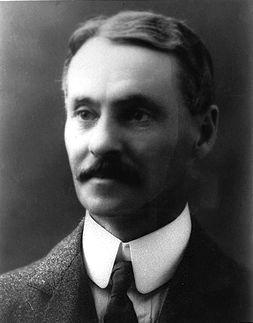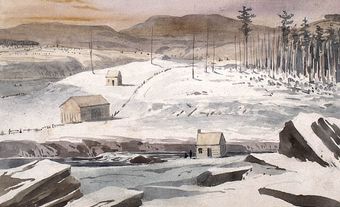One of the interesting characteristics of borders is that they often begin as arbitrary and artificial constructions, but over time they come to define highly significant social, economic and political distinctions.
So how were the borders that turned some western Canadians into Albertans and others into Saskatchewanians (and Manitobans for that matter) drawn? And if the political calculations had been different, how might the history of the west in Canada have changed?
By 1904, most politicians agreed that the more heavily populated areas of the North-West Territories should be granted provincial status. The Liberal and Conservative parties only disagreed on details such as the timing and form of this change. The Conservative Party argued for a swift resolution of the issue, so premiers Rodmond Roblin of Manitoba and Frederick Haultain of the North-West Territories campaigned for a Conservative victory in the 1904 federal election.

|
| Under Sir Rodmond Palen Roblin, Manitoba created a successful government telephone system and established the first effective public utilities commission in the nation (courtesy Provincial Archives of Manitoba/N-10863). |
Roblin wanted to see Manitoba's boundaries expanded westwards (and not to the north as they were in 1912). Under Roblin's plan much of the then well-established farm region in what is now southeastern Saskatchewan would have been added to Manitoba. Haultain's approach envisioned no expansion of Manitoba, but rather the creation of a single province comprised of most of what would become Alberta and Saskatchewan. He argued that only a single province, which he proposed be called "Buffalo," would give western Canadians real power in Ottawa.
Had the Conservatives won, a compromise could have been brokered, allowing for some modest expansion of Manitoba and the creation of a single province out of what remained. How this might have changed the history of western Canada is a matter of pure speculation, but the consequences would almost certainly have been significant. Manitoba would have enjoyed an immediate boost of population, income and political representation in Ottawa, and Haultain's "Buffalo" would have been a very different place from the Alberta and Saskatchewan we now know.
For example, as Territorial capital, Regina would almost certainly have emerged as the capital of the new province, and not Calgary or Edmonton. The population would have rivalled British Columbia, and the province would have combined enormous agricultural production with significant mineral wealth. Other differences might also have emerged as well. For example, rather than Calgary or Saskatoon, Edmonton might have developed as the major rival to Regina since most of the major oil and gas discoveries since 1947 have been made in the northern half of the current province of Alberta.
Politically the implications are equally fascinating. Alberta only surpassed Saskatchewan in population after the discovery of oil at Leduc in 1947. Much of the population of the new province then would have been made up of people we now think of as Saskatchewanians. Social Credit might not have been able to sweep to power in 1935, and instead the Cooperative Commonwealth Federation party might well have come to office instead. The implications of a politically left-of-centre government with control over the natural resource wealth of the oil patch could have completely rewritten the development of federal provincial relations in Canada and the structure of political parties both federally and provincially.
Unfortunately for Roblin and Haultain's plans, the Conservatives lost the 1904 election to Wilfrid Laurier's Liberals. Manitoba's boundaries were not expanded, and any idea of a single large Prairie province was abandoned.

|
| A man of the centre, Sir Frederick Haultain strongly deplored the influence of partyism in politics and always insisted that it had no place in the West (courtesy Saskatchewan Archives Board). |
The question then became how to divide the North-West Territories. History and geography would have suggested the creation of two provinces more or less corresponding to the true prairie region of the southern plains and the parkland belt of the Saskatchewan and North Saskatchewan rivers. This division would have created one province centred on the Canadian Pacific Railway line and a more northerly province focused around the old Saskatchewan District of the fur trade. It would also have placed Edmonton and Calgary and Saskatoon and Regina in different provinces. The southern province would have been disproportionately devastated by the economic and social collapse of the 1930s, and this province would not have benefited to any major extent from the post-1947 oil boom or the development of the oil sands. Under such a scenario, it seems hard to believe that Calgary would emerge as a major corporate headquarters, and it might be the Saskatoon Flames challenging for the Stanley Cup a century later.
In 1905, however, history and geography gave way to partisan political advantage. Laurier and the Liberals had no intention of helping Haultain, Roblin or any other political rival out. Instead the new provinces were divided north-south along a wholly arbitrary line that reflected no geographic or cultural feature - even famously dividing the community of Lloydminster in half. The division was made because two provinces would be easier to control than one large one and a north-south split divided the potential strength of the Conservative Party which was concentrated in the south along the CPR mainline. In an act of political gerrymandering of staggering proportions, Laurier and his supporters were able to cobble together two Liberal administrations that survived in Alberta and Saskatchewan until 1921 and 1929 respectively.
And the rest, as they say, is history! Still, it is fascinating to speculate about what might have happened had different political decisions been made in 1904-05 - as well they might have.

 Share on Facebook
Share on Facebook Share on X
Share on X Share by Email
Share by Email Share on Google Classroom
Share on Google Classroom

